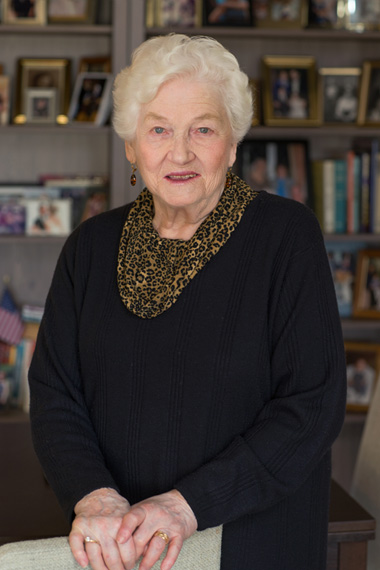Judith Meisel

we promised to remember
Judy Meisel is a wife, mother, teacher, civil rights activist and a Holocaust survivor. Her road to activism started with the injustices perpetrated on her new African-American neighbors in Philadelphia, her newfound home. As a survivor of the Kovno ghetto and Stutthof concentration camp she experienced unspeakable brutality and she was not about to let injustice happen in Philadelphia. “If their homes are not safe, my home was not safe. If their rights are trampled on, then my Jewish rights are trampled on at the same time.” So she baked cookies and marched through the hateful mob that surrounded the house to welcome her new neighbors.
Judy was twelve years old when the Nazis entered Lithuania in 1941 and she was a 47-pound sixteen-year old when she was liberated in Denmark in 1945. The story of her survival together with her sister Rachel is an odyssey that defies the imagination. They were enslaved, starved, beaten and terrorized. “From the time I got into the ghetto until the time we were liberated I never knew what would happen.”
In December 1944 Judy and her sister escaped from a transport during a heavy bombardment by the Allies. They were knocked into a ditch and were able to find their way to a farmhouse through the ice and snow. Two women and a Russian POW welcomed them, “It was as if she knew we were coming.” They were given food and a change of clothes and transported in a wagon to the banks of the Vistula River. During the night they crawled across the ice-covered river until they reached a convent. They stayed at the convent for several weeks. “ It was our first taste of freedom.” But the nuns felt that it was unsafe for them to remain unless they converted to Catholicism. “We wanted to live as Jews.” The two sisters left the convent with rosaries, disguised as good Catholic girls.
They travelled to Danzig where they worked for a German woman who ran an inn for Nazi soldiers. “Imagine two Jews working for the Nazis.” When the Allies began the bombing of Danzig they were told to flee to Nazi-occupied Denmark. They sailed for Denmark while the bombs were dropping. As soon as they were out of the harbor their boat was torpedoed. “I don’t know how long I was in the water, all I know is that I was so numb.” The sisters were rescued and taken to Denmark in a small boat. “I came to Denmark, I don’t know how I survived.” They were given clothing and food. “We thought we were the only Jews left. When we asked people, ‘How do you know there are Jews left?’ They replied, we know, we helped them cross to Sweden.”
It was incredible for the sisters to realize that they were finally safe. “ I owe my life to the Danes, not just my very life but my self-esteem as a human being.” It was unbelievable to think, “that in 1943 as we were in the Kovno ghetto, the Danes were taking their Jews across to Sweden.” And even more unbelievable that following the war King Christian and the Danish people welcomed them back. Other counties helped Jews leave, but only the Danes welcomed them back as full citizens.
Judy was especially lucky to have met Paula and Swen Jensen, a childless couple who not only welcomed her into their home and nursed her back to health, but “They created an incredible family for us with the other Danes.”
Judy has told her astonishing story to thousands of students around the country. “We promised that we would remember and tell the story.”
“Racism and bigotry, it’s still happening all over the world and we have to constantly work at it to see that this does not happen here or anywhere. We cannot afford to say, what can I do, I’m only one person. One person can do a lot.”

